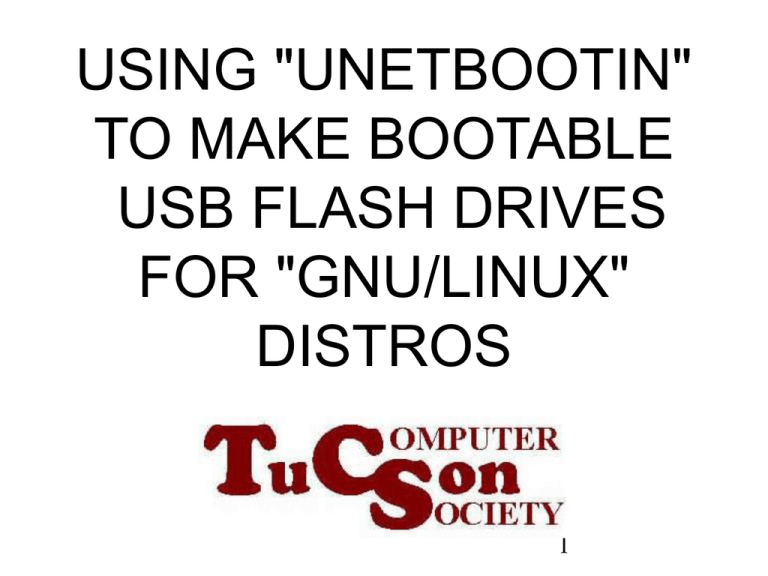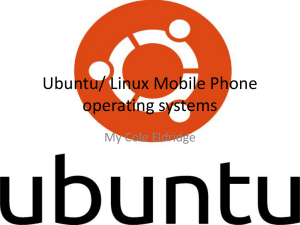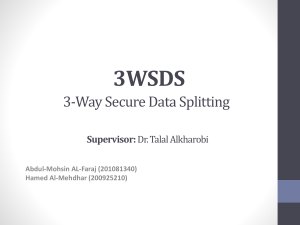more advice about "unetbootin" (continued)
advertisement

USING "UNETBOOTIN" TO MAKE BOOTABLE USB FLASH DRIVES FOR "GNU/LINUX" DISTROS 1 SUMMARY "UNetbootin" is a great, free portable software program that can be used to bootable USB flash drives/devices for booting up various distros of GNU/Linux. 2 BASICS OF USING "UNETBOOTIN" • "UNetbootin" is a free, portable software program that runs in Windows, Linux, and Mac computers. • Download links and end-user information can be found at http://unetbootin.sourceforge.net/ 3 4 5 BASICS OF.."UNETBOOTIN" (continued) • Additional advice about bootable USB flash drive devices can be found at http://sourceforge.net/apps/trac/u netbootin/wiki/guide and http://linuxathena.com/tutorials/bo ot-run-linux-pen-drive-unetbootin/ 6 WARNINGS ABOUT "UNETBOOTIN" • "UNetbootin" will fail to make a bootable USB flash drive device if the USB flash drive device has been formatted in the NTFS file system or, the FAT16 file system, or the exFAT file system!. 7 WARNINGS ABOUT "UNETBOOTIN" • If your USB flash drive device has been formatted with the NTFS file system or the exFAT file system, re-format the flash drive with FAT32 by using another software program or "applet": 8 WARNINGS ABOUT "UNETBOOTIN" (continued) • Ways to re-format a USB device: o "Disk Management" applet in the Windows "Control Panel". o "GParted"/"Partition Editor" in the "Parted Magic" distro of "GNU/Linux". 9 MORE ADVICE ABOUT "UNETBOOTIN" • When you run the Unetbootin software program to create the Linux-bootable USB flash drive, the first screen will have a section called: "Space to be used to preserve files across reboots (Ubuntu only)" The biggest that you can make this value is 9999 Megabyte = 9 Gigabyte. This value needs to be a little bit bigger than the sum total of all data files and folders that you plan to create and then edit in the "Home" folder when you are booted up with the Unetbootin flash drive device. 10 MORE ADVICE ABOUT "UNETBOOTIN" (CONTINUED) • The "Home" folder includes the following folders: "Desktop", "Documents", "Downloads", "Music", "Pictures", "Videos", etc. So please make sure that the "Space to be used to preserve.." value is big enough to accommodate all of these items both right now and in the future. 11 MORE ADVICE ABOUT "UNETBOOTIN" (CONTINUED) • When you are booted up into Ubuntu with the Unetbootin-created USB flash drive, you will be using a "RAM disk" instead of a real hard disk. When you log out of and shut down Ubuntu, the RAM disk disappears and your configuration files AND your Linux "Home" folder files are stored inside a proprietary file called Casper-RW inside the Unetbootincreated USB flash drive. 12 MORE ADVICE ABOUT "UNETBOOTIN" (CONTINUED) • This means that if you then insert the USB flash drive into a "Windows.." computer, you will be unable to access the data files that are inside your Ubuntu "Home" folder. 13 MORE ADVICE ABOUT "UNETBOOTIN" (CONTINUED) • If you want to access the same data files in both Windows and Unetbootin Ubuntu, you will have to use a second USB flash drive. 14 MORE ADVICE ABOUT "UNETBOOTIN" (CONTINUED) • You cannot use "Disk Management" in "Windows XP" to create a second hard drive partition on your Unetbootincreated flash drive. 15 MORE ADVICE ABOUT "UNETBOOTIN" (CONTINUED) • You can use GParted (in Parted Magic Linux, Ubuntu, or most other distros of Linux) to 1)shrink down the original FAT32 partition on your USB flash drive and 2) create a second partition on your USB flash drive. 16 MORE ADVICE ABOUT "UNETBOOTIN" (CONTINUED) • If you use GParted to create a second partition on your USB flash drive, Ubuntu will be able to access this partition when you are booted up in Ubuntu via Unetbootin. However, your Windows XP, Windows Vista, or Windows 7 computer will not be able to access this second partition. 17










